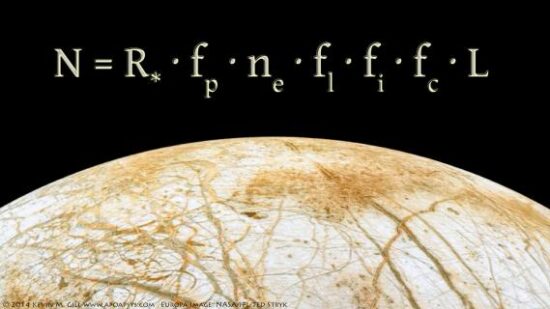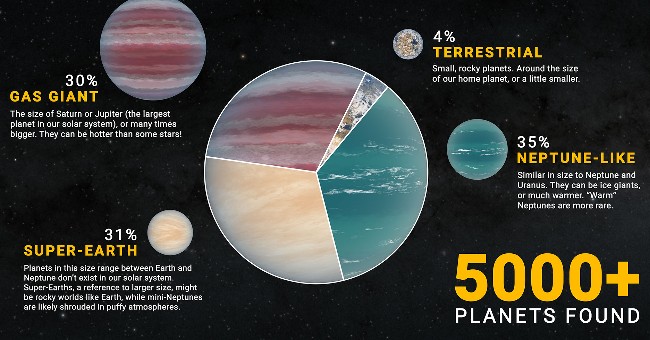The Kepler Space Telescope may be defunct but the data it sent to Earth is still uncovering a wealth of discoveries. A NASA posting on the first day of spring this week confirmed that the number of known exoplanets (planets outside our Solar System) has passed 5,000.
In the NASA announcement that put us over the top, 65 newly discovered exoplanets were added to the growing total. Stated Jessie Christiansen, at NASA’s Exoplanet Science Institute at Caltech, in Pasadena, California, “It’s not just a number. Each one of them is a new world, a brand-new planet. I get excited about every one because we don’t know anything about them.”
Kepler operated for nine years before NASA officially ended the mission in October 2018. Launched in March of 2009, and first conceived 35 years prior, its initial mission was to confine its search to an area in the sky near the constellation Cygnus. Its focus was 150,000 stars and its purpose was to detect Earth-size exoplanets orbiting in habitable zones around stars. After four years when some of the onboard equipment started failing, NASA switched the mission to alter the field of view four times a year which extended the mission and added more than 380,000 more stars to its observations and collected more than 678 Gigabytes of data that scientists continue to mine.
Kepler’s successor was launched in 2018. Called the Transiting Exoplanet Survey Satellite or TESS for short, its title describes the methodology it uses to find exoplanets circling distant stars. TESS has bumped up the numbers of discovered exoplanets considerably, almost doubling that which Kepler found.
Even more powerful than TESS is the James Webb Space Telescope which by this summer will start among its many tasks, a study of the atmospheres of previously discovered exoplanets. Atmospheric composition is seen as a key indicator of life. And it doesn’t stop with the James Webb. In 2027, the Nancy Grace Roman Space Telescope will launch to begin its search for exoplanets. And then in 2029, the European Space Agency (ESA) will launch ARIEL, the Atmospheric Remote-sensing Infrared Exoplanet Large-survey, a space telescope that will search for Earth-Twos.
In the exoplanet mix so far, are there Earth Twos? Of the more than 5,000 exoplanets found, 4% or approximately 200 are Earth-like in size and rocky in composition. The next category deemed Super-Earths, are larger than our planet and smaller than Neptune. Of these, there are more than 1,500. Some are rocky and potentially accommodating to life while others are gas and ice planets similar to Neptune and Uranus. Then there are the planets that are more like Jupiter and Saturn, or even larger. And some of these aren’t ice giants, but rather hotter even than the stars they circle.
The sample of 5,000 plus exoplanets is really quite small. Astronomers know that Kepler’s limited observations in yielding so many planets means that there are likely trillions in our galaxy alone. Think about that. Even if the number was only one trillion, that’s 1,000, 000,000, 000, and current sampling ratios hold at 4%, it would mean the number of Earth-like rocky planets would total 40 billion.
In the past, I have written about the Fermi Paradox and the Drake Equation.
Enrico Fermi, the noted physicist, in 1950 once asked a group of fellow scientists “where is everybody?” The conversation that spawned this question happened over lunch and was inspired by the spate of UFO sightings in the news at the time. Fermi was questioning the lack of radio signals and other evidence of technological civilizations coming from space.
The Drake Equation, (see below) was first proposed by astrophysicist Frank Drake in 1961, as he attempted to develop a formula to calculate the number of advanced and observable technological civilizations in the Milky Way galaxy.
 A break down of the equation goes like this:
A break down of the equation goes like this:
N: represents what would be the total number of advanced technological civilizations producing detectable electromagnetic emissions. The calculation of that number would be determined by putting best guess values to each of the elements in the formula with:
R*: representing the rate of star formation that would be suitable for Earth-like planets and ultimately the development of intelligent life as calculated per Earth-year.
fp: representing a fraction of the above stars that would have planets (that number when first proposed is turning out to be a significant underestimate as it appears almost every star has multiple planets circling them).
ne: representing the subset of planets suitable for life.
fl: representing the subset of those planets where life actually appears.
fi: representing the subset where intelligent life emerges.
fc: representing a further subset where intelligent life leads to the development of a technological civilization that produces detectable signals to indicate they exist.
L: representing the duration in years for the life of such civilizations (Drake was trying to anticipate how advanced technological civilizations might self-destruct. Think nuclear war for example.)
Drake’s best assumptions yielded a number ranging between 1,000 and 100,000,000 advanced technical civilizations enduring between 1,000 and 100,000,000 years. Even if his low-end number proved right it represents an astounding figure. And in answer to Fermi, the distances that electromagnetic signals would have to travel given the size of the Milky Way presents a challenge. On Earth, we have been producing electromagnetic signals that have reached into space for less than a century, so not even 100 light-years in distance. If other technologically sophisticated intelligence has emerged on a planet within the radius of our signals reach and they choose to send out some kind of response, we may get something back in this century. And then if we try to figure out the message and send a response our interaction over time and space will take centuries.
But SETI (the Search for Extraterrestrial Intelligence) is undaunted in the search for those signals from space while NASA, ESA and others continue to seek exoplanets with characteristics suitable for life and evidence that it exists elsewhere other than here on Earth.
When Carl Sagan wrote Contact, he had his heroine, Eleanor Arroway (played by Jodie Foster, in the 1997 movie) state an observation and pose a question that her father once asked her. She was talking to students visiting the large radio telescope array in Socorro, New Mexico, and this is what she said:
“The universe is a pretty big place. If it’s just us, seems like an awful waste of space.”
So congratulations to NASA and others who have contributed to achieving the 5,000+ exoplanet milestone. We know it’s just a drop in the Milky Way ocean of exoplanets yet to be discovered. And we continue to pose these questions.
How many will be Earth Twos?
How many will have life?
How many will have intelligent life?
How many will be spacefaring?
The N in the Drake equation remains unsolved.








